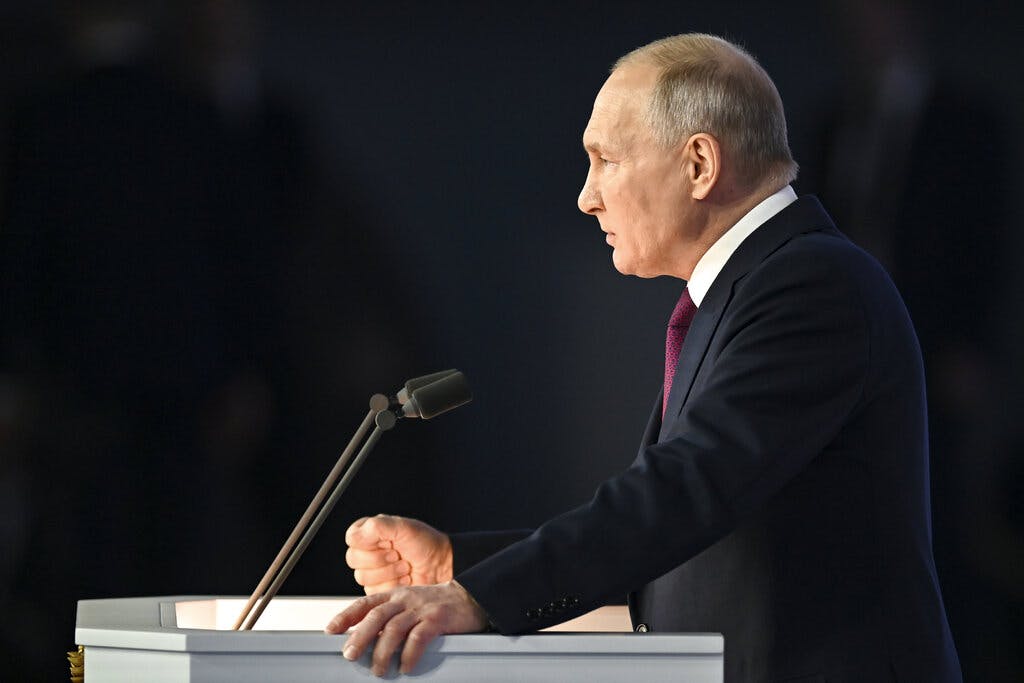Why Putin’s New Start Taunt Bombed Out
The Russian president is now more boxed in than he could ever publicly admit.

With Russia and Ukraine locked in an attritional battle in the Donbas, the news less reported is that nearly a year after the Russian invasion, Moscow is also now essentially locked out of the capital region and much of western Ukraine. Ukrainian valor and Western weapons have much to do with that, as does an old Russian bugbear that dare not speak its name: fear.
So, incapable of pulling a juicy rhetorical rabbit out of his hat on a day when President Biden stole the show, Vladimir Putin opted for rattling his nuclear saber. Yet it was less a command performance than a woozy encore.
That assessment reverberated across much of the global press, which just two days ahead of the bleak one-year milestone of the Kremlin’s folly is hungry for signs of closure, or at least a functioning compass. The Russian president’s decision to hit pause on the New Start arms control treaty and then boast about it at the Russian equivalent of a State of the Union address was designed to keep everyone guessing.
Mr. Putin said Russia would be “suspending its participation” in Start, though not withdrawing from it. Also, as CNN noted, one of the key elements of the treaty — American and Russian inspection of each other’s weapons sites to ensure compliance — was already on hold since 2020 because of the Covid-19 pandemic.
As important as inspections are, especially considering that we are talking about nuclear warheads that can destroy the planet and not cage-free eggs, they are only one component of the treaty. Other verification measures on nuclear weapons stockpile limits include the exchange of telemetric information, the operation of a database of treaty-required information, and the operation of the Bilateral Consultative Commission. Given that inspections have already been paused for more than two years, though, Mr. Putin’s new reason for prolonging that de facto suspension can only be seen as a misguided form of retaliation.
In his long-winded address, Mr. Putin said that in his view, “NATO is complicit in the attempts by the Kyiv regime to strike our air bases. And the drones used for this have been equipped and modernized by NATO specialists. And now they want to come and inspect our bases? Given the current confrontation, this just sounds like complete nonsense.”
He also claimed that America is developing new types of nuclear weapons and that the Russian defense ministry and Rosatom, the state nuclear energy entity, “should be ready to test nuclear weapons if the United States does it first.”
It is unsettling stuff, particularly for those of us who lived through the Cold War’s early 1980s chapters and the more obvious ones before. Yet the Russian president is now more boxed in than he could ever publicly admit. Ukraine has in the course of Moscow’s war hit back at Russian air bases inside not only Russian-occupied Crimea but deep inside the Russian Federation itself.
That hasn’t stopped the Kremlin propaganda machine from swinging into gear. On Wednesday Russia’s fairly level-headed deputy foreign minister, Sergei Ryabkov, confirmed that all dialogue and “information exchanges within the framework of the agreement cease to operate.” He also said that the nuclear arsenals of Britain and France will be considered as “a single fist” with the United States, “directed against Russia.”
A feisty statement but one that rings a little hollow: Britain has an estimated 225 nuclear warheads, France 300. Even adding those to the estimated 5,428 in America’s arsenal, it is still fewer than Russia’s estimated 5,977 warheads; in other words, Kremlin bluster aside, there is no change to the nuclear parity equation.
Given that fact, the withering response to Mr. Putin’s announcement from the NATO chief, Jens Stoltenberg — that “the whole arms control architecture [in Europe] has been dismantled” — may be somewhat overblown.
The Guardian newspaper characterized the suspension as “an illusion, since no suspension clause is contained in the treaty and Putin is in no position to start a nuclear arms race with the US.”
A senior researcher with the UN Institute for Disarmament Research, Pavel Podvig, said in a tweet, “Arms control reflects the status of the relationship, so no surprises. I don’t think we will see a nuclear buildup.” Mr. Podvig added that “given the circumstances, it could have been worse.”

